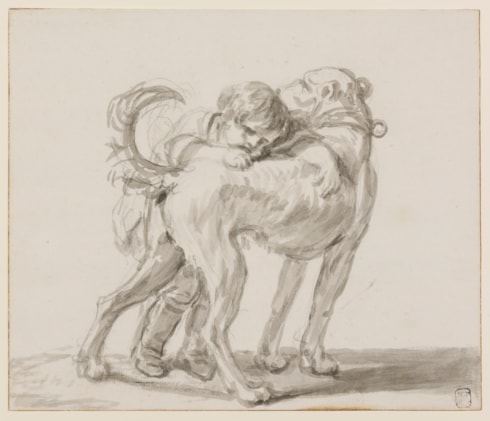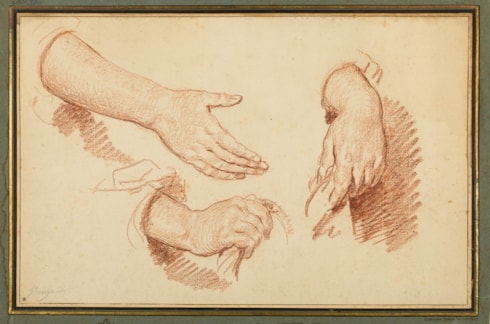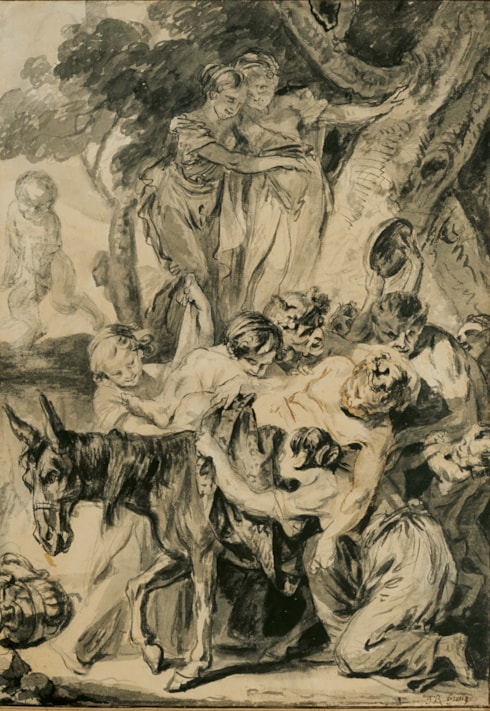
Jean-Baptiste GREUZE
Tournus 1725 - Paris 1805
Biography
Following a period of study in Lyon, Jean-Baptiste Greuze arrived in Paris sometime in the early 1750s and began studying drawing with Charles-Joseph Natoire and Louis de Sylvestre. Very little is known of the artist’s early Parisian period, however. He was admitted into the Académie Royale as an associate member in 1755, in the category of peintre de genre particulier, and the same year exhibited several works at the Salon with some success, with three of the paintings acquired by the influential collector Ange Laurent de La Live de Jully. (Greuze did not, however, supply a morceau de recéption to the Académie, which was required in order to gain full membership as an Academician, until 1769.) In September 1755 the young artist travelled to Italy with another influential patron, the Abbé Gougenot, and he worked in Rome, mainly on portrait commissions and genre paintings, until the spring of 1757. Greuze’s paintings of moralizing genre subjects, exhibited at the biennial Salons from 1761, earned him the praise of the influential critic Denis Diderot. He was also a fine portraitist, exhibiting a number of portraits at the Salon throughout the 1760s to considerable acclaim.
While Greuze enjoyed the patronage of such prominent collectors as La Live de Jully, Madame de Pompadour and her brother, the Marquis de Marigny, Jean de Jullienne, the Duc de Choiseul and the Empress Catherine II of Russia, his difficult temperament often alienated other clients. (Indeed, even the artist’s great champion Diderot, writing to the sculptor Etienne Falconet in 1767, described Greuze as ‘an excellent artist but a bad-tempered fellow. One should collect his drawings and his pictures and otherwise leave him alone.’) Notwithstanding his success as a painter of genre subjects and portraits, Greuze always aspired to be recognized as a history painter. Throughout the 1760s he had considered various themes for his long-overdue morceau de reception for the Académie Royale, which he wanted to be of a mythological, Biblical or historical subject. In 1769, some fourteen years after he was agrée at the Académie, he finally submitted a painting of Septimus Severus Reproaching Caracalla as his reception piece. However, the work was rejected by the Académie, who instead admitted the artist only as a genre painter. Angered and humiliated by this snub, Greuze henceforth refused to exhibit at the Salons, choosing instead to show his paintings in his studio in the Louvre, where they attracted a good deal of public interest. He continued to enjoy considerable success throughout the 1770s and 1780s, especially among Russian patrons, and also profited from the sale of prints after his works. His reputation began to suffer in the years after the Revolution and with the rise of Neoclassicism, although by 1800 he had returned to exhibiting his works at the Salon, after an absence of thirty-one years, and continued to do so until 1804, when among the works he showed was a fine self-portrait. Greuze died, in his studio, at the age of nearly eighty, and was buried in the cemetery of Montmartre.
Greuze was a gifted and versatile draughtsman, equally adept in chalk, pastel and ink. From 1757 onwards he regularly showed finished drawings as well as oil paintings at the Salons, and one critic, writing of the 1761 exhibition, noted ‘Several drawings by M. Greuze...do him as much honour by their execution as by the choice and genius of their invention.’ The artist’s drawings were also often praised by Diderot, who noted that ‘this man draws like an angel…He is enthusiastic about his art: he makes endless studies; he spares neither care nor expenses in order to have the models that suit him.’ Greuze produced many preparatory studies, including compositional studies in pen and ink and head, hand and figure studies in chalk, for each of his painted compositions. A particular interest was the study of physiognomy and facial expression, made manifest through large-scale drawings of têtes d’expression. These drawings of heads, usually in red chalk, allowed the artist to refine the facial types and expressions that were such an important part of his paintings, but they were also produced as independent works of art, to be sold to collectors. Indeed, Greuze enjoyed a healthy market for his finished drawings; as the 18th century collector and connoisseur Pierre-Jean Mariette noted of him, ‘Il a fait aussi nombre de desseins, qui, dans le commencement, lui ont été payés prodigieusement par quelque curieux.’ Greuze’s drawings found their way into important 18th century collections in France, Russia and Germany, while several fellow artists, including Aignan-Thomas Desfriches, Claude Hoin, Joseph-Marie Vien and Johann Georg Wille, owned drawings by him.




